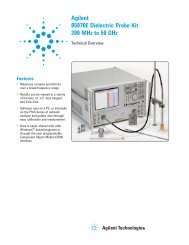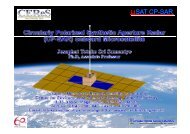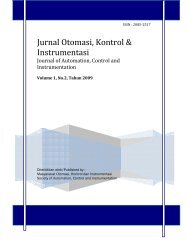Development of Circularly Polarized Microstrip ... - CEReS - åè大å¦
Development of Circularly Polarized Microstrip ... - CEReS - åè大å¦
Development of Circularly Polarized Microstrip ... - CEReS - åè大å¦
You also want an ePaper? Increase the reach of your titles
YUMPU automatically turns print PDFs into web optimized ePapers that Google loves.
Chapter 3<br />
<strong>Circularly</strong> <strong>Polarized</strong> <strong>Microstrip</strong><br />
Antenna<br />
3.1 <strong>Microstrip</strong> antenna<br />
Nowadays, the microstrip antennas continuously develop to become one <strong>of</strong> the most attractive<br />
antenna options in a wide range <strong>of</strong> modern microwave systems. This fast growth in microstrip<br />
antenna applications and uses derived a continuous research effort for developing and improving<br />
its characteristics (Pozar, 1992 and Garg et al., 2001). In general, a microstrip antenna can<br />
attain a narrow frequency bandwidth at the expense <strong>of</strong> a low gain. As compared with conventional<br />
microwave antennas, a microstrip antenna has additional advantages such as a compact<br />
size, light weight, conformability to surfaces <strong>of</strong> substrates, low cost, and easier integration with<br />
other circuits and versatility (Garg et al., 2001). From a designer point <strong>of</strong> view, a microstrip<br />
antenna presents a wide range <strong>of</strong> options. The designer can vary the choice <strong>of</strong> the substrate<br />
type, the antenna structure, type <strong>of</strong> perturbation and the feeding technique to achieve the<br />
antenna design objective (Balanis, 2005 and Lo and Lee, 1993).<br />
Basically, <strong>Microstrip</strong> antenna consists <strong>of</strong> four parts (Figure 3.1), radiating patch, dielectric<br />
substrate, ground plane and feeding line. Where L is the length <strong>of</strong> the patch, W is the width<br />
<strong>of</strong> the patch, h is the dielectric substrate height and ε r substrate relative permittivity. Many<br />
29






